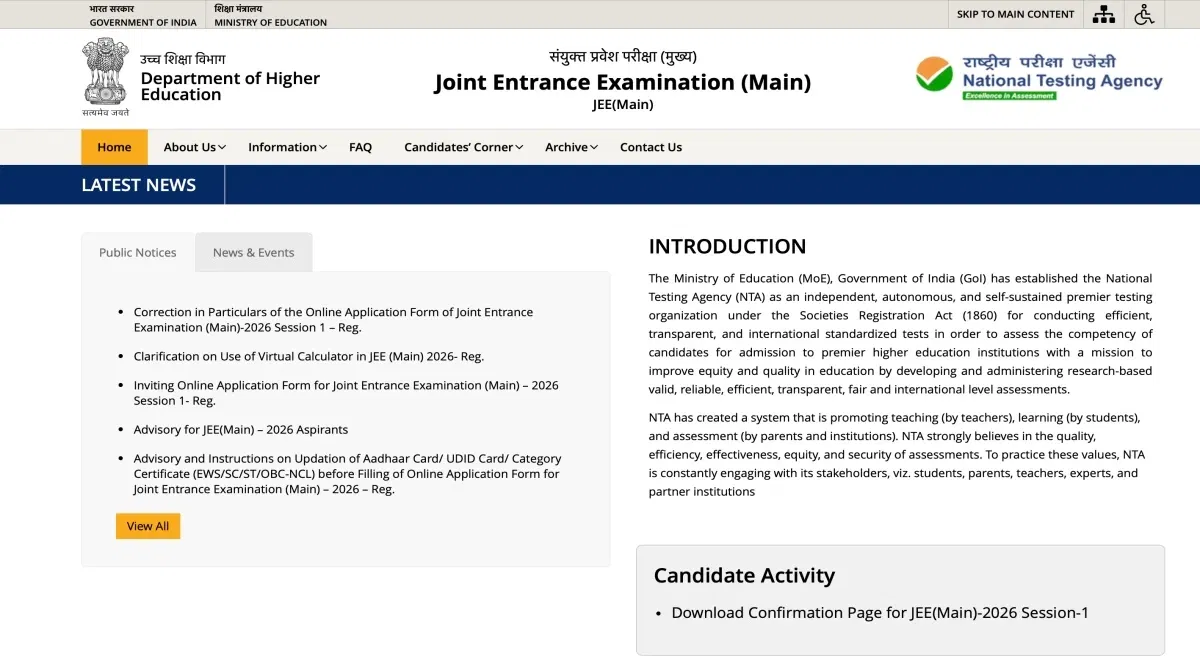The minimum rank in JEE Advanced to get IIT for general category must be under 20000 to secure a seat in top branches like CSE, ME, ECE, etc. Know more about category-wise cutoffs, course-wise closing ranks, marks vs rank trends, and how to secure top IIT branches
Table of Contents
- What is the Minimum Rank Required in JEE Advanced for IIT Admission 2025
- Minimum Rank Required in JEE Advanced for IIT
- Minimum Marks in JEE Advanced 2025 to get IIT for General:
- Course-wise Minimum Rank Required in JEE Advanced for IIT
- JEE Advanced Marks vs Rank for IITs
- Top Courses Offered at IIT Through JEE Advanced 2025
- IIT Admission Process 2025 Through JEE Advanced 2025
Securing a seat in an IIT through JEE Advanced 2025 requires meeting specific rank thresholds that vary by category and branch. In general, the closing rank (highest rank admitted) for General (Open) category seats ranges from just a few dozen for top branches to several thousand for lower-demand fields.
For context, there are about 17,385 B.Tech seats in all IITs. This means the overall rank cutoff for even the last seat falls in the low tens of thousands. For example, IIT Bombay’s B.Tech (CSE) last admitted general category student at rank 68 in 2024, whereas its Civil Engineering closed around 4046. In general, a rank within roughly the top 10,000–15,000 will secure an IIT seat (especially in core branches), and ranks approaching the total seat count (~17–18k) are typically the final cutoffs for the lowest-demand branches.
JEE Advanced previous year's marks-vs-rank data shows that a score of ~97–109 marks (≈35% of 300/500) corresponded to rank 15,001–20,000, roughly where the last qualifying candidates fell. Thus, to “get an IIT” in 2025, a general category aspirant usually needs to be well under rank 20,000, with more competitive branches requiring much higher ranks (often under a few thousand).
What is the Minimum Rank Required in JEE Advanced for IIT Admission 2025
The minimum rank for an IIT seat essentially means the closing rank in the General category. This depends heavily on the branch and institute. As noted, top branches like CSE admit students with very high JEE Advanced ranks (e.g. rank ~60–100 at older IITs), whereas other fields like Civil or Aerospace may close in the thousands. With about 17.4k seats, the absolute last IIT seat could go to someone around that rank, but typically the practical cutoff for General is a bit lower.
For instance, the JEE Advanced previous year analysis shows that ranks 20,000–26,321 correspond to scores of ~86–97 marks, which are near the very bottom of the qualifying list. In short, top 10k ranks are generally well within the safe zone for IIT admission (across all branches), while ranks up to ~15–18k may still get lesser-preferred branches. For example, in 2024 only ranks ≈1–68 got CSE seats at IIT Bombay; in contrast, an IITB Civil seat went to rank 4046. In other older IITs, CSE closing ranks were also under 300 (e.g. IIT Delhi ~116, IIT Madras ~159). Thus, as a rule of thumb, aim for a rank below 5,000–10,000 to be competitive for most IIT branches, especially in the General category. (Score-wise, the minimum qualifying marks were only 109 for General, but to secure a seat, one needs much higher marks and hence a better rank.)
Minimum Rank Required in JEE Advanced for IIT
JEE Advanced cutoffs are significantly relaxed for reserved categories. The qualifying percentage for JEE Advanced in 2024 was 35% for General (about 109 marks), 31.5% for OBC-NCL/EWS (98 marks), and 17.5% for SC/ST (45–54 marks). This means SC/ST candidates can enter the rank list with much lower scores, so their admission ranks can be correspondingly higher. As an example, while a General candidate needed at least ~109 marks to qualify, an SC candidate needed only ~45.
|
Sr. No. |
Category |
Minimum Percentage of Aggregate Marks |
Minimum Aggregate Marks (out of 360) |
|
1 |
General |
16.39% |
59 |
|
2 |
General-EWS |
14.82% |
53 |
|
3 |
OBC-NCL |
14.82% |
53 |
|
4 |
SC |
8.27% |
30 |
|
5 |
ST |
8.27% |
30 |
|
6 |
Gen-PwD |
8.27% |
30 |
|
7 |
Gen-EWS-PwD |
8.27% |
30 |
|
8 |
OBC-NCL-PwD |
8.27% |
30 |
|
9 |
SC-PwD |
8.27% |
30 |
|
10 |
ST-PwD |
8.27% |
30 |
|
11 |
Preparatory Course (PC) |
3.26% |
12 |
Minimum Marks in JEE Advanced 2025 to get IIT for General:
The closing ranks for reserved seats stretch far beyond the General cutoffs. For instance, an SC seat in an IIT might admit students well above rank 20,000 (depending on the branch). EWS (Economically Weaker Section, 10% quota) and OBC-NCL (27% quota) have cutoffs close to General, but still slightly lower rank requirements. The table below shows the minimum marks required in JEE Advanced for admission into IIT for general category candidates:
|
Sr. No. |
Rank List / Category |
Minimum % of Marks in Each Subject |
Minimum % of Aggregate Marks |
|
1 |
Common Rank List (CRL) |
7% |
74% |
|
2 |
GEN-EWS Rank List |
6% |
66% |
|
3 |
OBC-NCL Rank List |
6% |
66% |
|
4 |
SC Rank List |
3% |
37% |
|
5 |
ST Rank List |
3% |
37% |
|
6 |
Common-PwD Rank List (CRL-PwD) |
3% |
37% |
|
7 |
GEN-EWS-PwD Rank List |
3% |
37% |
|
8 |
OBC-NCL-PwD Rank List |
3% |
37% |
|
9 |
SC-PwD Rank List |
3% |
37% |
|
10 |
ST-PwD Rank List |
3% |
37% |
|
11 |
Preparatory Course (PC) Rank List |
1% |
18% |
In summary, General category sees the highest cutoff ranks; OBC-NCL and EWS cutoffs are somewhat lower, and SC/ST even lower. (Exact opening/closing ranks by category are published by JoSAA, but broadly the pattern is as above.) The JoSAA 2025 seat matrix confirms the reservation split (10% EWS, 27% OBC-NCL, 15% SC, 7.5% ST). Overall, a General rank below ~10k is competitive, whereas OBC-NCL/EWS candidates might get in with ranks somewhat higher, and SC/ST candidates with even higher ranks, reflecting their lower qualifying scores.
Course-wise Minimum Rank Required in JEE Advanced for IIT
Cutoff ranks vary sharply by branch of engineering. Across 2023–24 data, the most sought-after streams (CSE, ECE, EE) had very low closing ranks; core streams (ME, Civil, ChemE) closed higher. Some representative closing ranks (General category) are:
|
Branch |
Institute |
2022 Rank |
2023 Rank |
2024 Rank |
2025 Rank |
|
CSE |
60 |
66 |
68 |
67 (similar) |
|
|
102 |
115 |
116 |
118 (minor rise) |
||
|
175 |
144 |
159 |
160 (stable) |
||
|
94 |
215 |
248 |
250 (stable) |
||
|
ECE |
1408 |
1382 |
1410 |
1430 (slightly higher) |
|
|
1690 |
1597 |
1610 |
1605 (stable) |
||
|
4110 |
4641 |
4798 |
4800 (stable) |
||
|
ME |
IIT Bombay |
1685 |
1691 |
1382 |
1400 (uptrend) |
|
IIT Delhi |
1774 |
1757 |
1865 |
1870 (flat) |
|
|
IIT Kanpur |
2736 |
2844 |
2962 |
2980 (flat) |
|
|
IIT Madras |
2302 |
2509 |
2677 |
2680 (flat) |
|
|
EE |
IIT Bombay |
464 |
369 |
469 |
470 (stable) |
The tables above summarize trends in closing ranks by course. In general: CSE demands the highest ranks (best performance); ECE/EE require ranks in the low hundreds; Mechanical, Civil, Chemical, etc. typically accept ranks in the thousands. Lower-tier IITs have higher numeric cutoffs (weaker scores) – for example, many newer IITs’ CSE branches close beyond rank 1000. The key takeaway: to get a popular branch like CSE/ECE at a top IIT, you likely need a rank well under 1000, whereas branches like ME or EE at those IITs allow ranks in the thousands.
JEE Advanced Marks vs Rank for IITs
An important tool for aspirants is converting JEE Advanced score to expected rank. The following table gives approximate rank ranges for total marks:
|
All-India Rank Range |
Approx. Total Marks (2023) |
|
1 – 500 |
341 – 242 |
|
501 – 1000 |
241 – 219 |
|
1001 – 1500 |
218 – 203 |
|
1501 – 3000 |
202 – 174 |
|
3001 – 5000 |
173 – 153 |
|
5001 – 10000 |
152 – 125 |
|
10001 – 15000 |
125 – 109 |
|
15001 – 20000 |
109 – 97 |
|
20001 – 26321 |
97 – 86 |
For example, scoring ~310 marks in JEE Advanced 2023 (≥ 80% score) corresponded to a rank within 1–100, whereas a score of ≈100 marks yielded a rank around 15,000–20,000. This table helps estimate the marks needed for a target rank. Note that the exact marks cutoff shifts each year, but as a rule of thumb, higher marks correlate to exponentially better ranks in the top ranges.
Top Courses Offered at IIT Through JEE Advanced 2025
IITs offer undergraduate programs in a wide range of engineering fields. The most sought-after B.Tech branches include:
- Computer Science & Engineering (CSE)
- Electronics & Communication Engineering (ECE)
- Mechanical Engineering (ME)
- Electrical Engineering (EE)
- Civil Engineering (CE)
- Aerospace Engineering (AE)
- Chemical Engineering (ChemE)
- Metallurgical Engineering, Engineering Physics, Industrial Engineering, Bio-Engineering, etc.
In total there are about 17,385 B.Tech seats in 2025. Over one-quarter of seats are in CSE/ECE/EE/ME branches combined. Admission to any of these courses is through JEE Advanced rank. The most competitive (CSE/ECE/EE) have the highest cutoffs as seen above. When counseling begins, candidates rank these courses by preference during JoSAA (Joint Seat Allocation Authority) choice filling.
IIT Admission Process 2025 Through JEE Advanced 2025
There are multiple steps in the IIT admissions process:
- To be eligible for JEE Advanced, candidates must first pass the JEE Mains percentile cut-offs. After that, they take the JEE Advanced 2025 exam. Candidates must receive at least 35% of the possible points in order to be listed on the JEE Advanced rank list (109/500 in 2024 for General).
- NTA/JEE releases rank lists (Common Rank List and category rank lists) following JEE Advanced. There were roughly 26,321 ranks allotted for 2024.
- Students who meet the requirements sign up on the JoSAA website. They rank the IITs and course options according to their preferences. JoSAA assigns seats based on the candidates' JEE Advanced ranks and the official seat matrix, which displays a total of around 17385 IIT seats.
- JoSAA does up to six allocation rounds. Based on their rank and category, each round assigns a student to the highest-preference course that is still open to them. JoSAA releases the starting and finishing rankings for every course in every round (for example, prior trends can be found in the tables in Section 3 above).
- The candidate reports to the designated IIT for document verification and to finish the admissions procedures after a seat is assigned. Students may wait for subsequent rounds or take part in slide-up/float alternatives in accordance with JoSAA regulations if they were unable to secure their preferred seat.
Knowing that passing the cutoff isn't enough is crucial if you want to get into an IIT through JEE Advanced 2025. Even though the General category minimum qualifying score is anticipated to be approximately 109, it typically takes much more to get a seat, especially in a reputable branch. Depending on historical patterns, a score of 125 to 150 could place you in the top 10,000 and give you a good chance of getting into select IITs and branches. However, you will probably need to receive at least 220 points in order to place below the top 500 if you are aiming for highly sought-after degrees like computer science.







![Indian Institute of Technology, [IIT] Kanpur](https://media.getmyuni.com/azure/college-image/small/indian-institute-of-technology-iit-kanpur.jpg)
![Indian Institute of Technology, [IIT] Roorkee](https://media.getmyuni.com/azure/college-image/small/indian-institute-of-technology-iit-roorkee.jpg)
![Jawaharlal Nehru University, [JNU] New Delhi](https://media.getmyuni.com/azure/college-image/small/jawaharlal-nehru-university-jnu-new-delhi.jpg)
![University of Calcutta, [UC] Kolkata](https://media.getmyuni.com/azure/college-image/small/university-of-calcutta-uc-kolkata.jpg)





























POST YOUR COMMENT